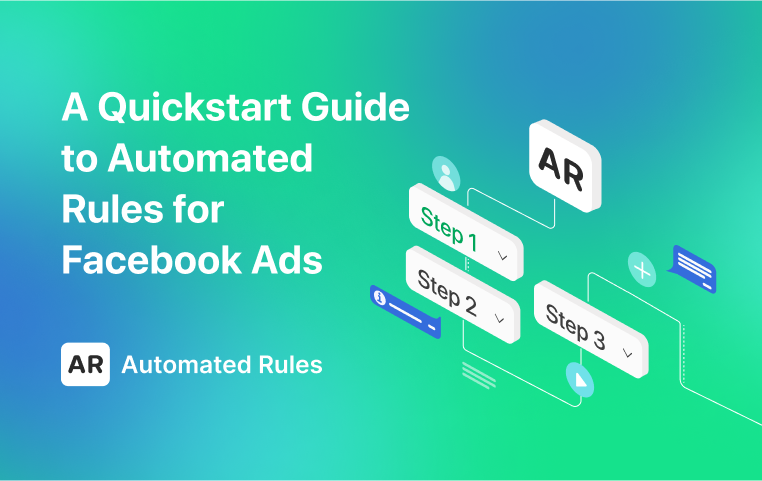Email Marketing Mastery: Strategies to Build Your Email List
January 3, 2024
Get ready to unleash the full potential of email marketing with insights, strategies, and tools that will help you take your campaigns to new heights.

Building an email list is more than just gathering addresses; it's about creating a relationship that turns indifferent viewers into enthusiastic prospects. It is a crucial tactic for marketers.
Let's review the basics. An email list is a collection of email addresses together with additional information, like name, gender, and location, that is created by gathering information from customers, website visitors, event attendees, and so on. Consequently, list building is the act of gathering email addresses from visitors, prospects, and customers. This can be accomplished through the use of a website, social media accounts, events, in-store signup sheets, and other means. Online signup forms, pop-ups, website pages, and social media profiles can all be used for list development.
The power of email list development lies in its ability to create a customized connection between companies and their clients. Building an email list, as opposed to using more general marketing techniques, allows businesses to customize their communications and send information right to the inbox of people who are actually interested in what they have to offer. This focused strategy raises the general efficacy of marketing initiatives while also improving client satisfaction.
However, behind the seemingly simple procedure comes a complex task filled with challenges. The complexity arises from the need to balance the urgency of connection with the necessity of precision. Building an email list requires careful attention to detail, from crafting compelling content that resonates with the audience to navigating the legalities of permission-based marketing. Every step of the way presents challenges that call for a careful balancing act between creativity and adherence to industry standards.
Marketing managers who want to become experts in email list creation must navigate this complex landscape with both strategic proficiency and a deep comprehension of the nuances involved. In this article, we explore the intricacies of email list creation. Come along for this exploration, where marketing managers looking to improve their strategy will find insights and practical tactics to help them master email list growth!
What makes a good email list
Knowing the qualities of a strong email list is crucial. Think about these qualities of a successful email list that make it not just good but exceptional:
- Relevant audience
At the heart of a high-quality email list beats the pulse of relevance. It's about the profound quality of your subscribers. Picture this—your messages landing in the inboxes of individuals genuinely interested in your offerings. Perfect, right? To achieve this, the foundation is laid by identifying and attracting a relevant audience. These are the individuals whose needs align seamlessly with what your business provides.
- Permission-based
The meaning of permission-based marketing cannot be overstated. A high-quality email list is one where subscribers have willingly opted to receive your communications. This isn't just a best practice; it's a golden rule. You may make sure that people welcome your messages instead of writing them off as unwelcome interruptions by getting specific agreement. This not only fosters a positive brand perception but also aids in maintaining compliance with data protection regulations.
- Easy segmentation
Segmentation is the secret sauce that transforms your email list from a generic database into a strategic asset. A high-quality list is one that allows for easy segmentation based on various criteria—demographics, purchase history, engagement levels, and more. This segmentation empowers you to tailor your messages with surgical precision, delivering content that resonates on a personal level.
- Regular updates
Regular updates ensure that your list remains a living, breathing entity, reflective of the ever-evolving preferences and behaviors of your audience. This isn't just about removing invalid addresses and ensuring that your messages reach those who are actually interested. This is also about constantly growing the list. Consider using lead magnets, social media promotions, or collaborations with other businesses to attract new subscribers.
- Unsubscribe option
Respect is at the core of effective email marketing, and providing an easy and visible unsubscribe option is a manifestation of that respect. A high-quality email list acknowledges that preferences change and that individuals should have the autonomy to opt out. This not only aligns with ethical marketing practices but also contributes to maintaining a positive sender reputation.
Want to elevate your campaigns from noise to meaningful engagement? Well, try using these attributes — they are the keys to unlocking the full potential of your email marketing activities.
Ways of capturing emails
Building a great email list requires a planned strategy and patience. You can't just use emails you discover online or ask website visitors for their email addresses. In order to attract and later engage an audience, it will be necessary to build a comprehensive strategy and carefully consider each area. Let us investigate the various ways that can change this routine chore into an enjoyable activity.
1. Use embedded sign-up forms
At the forefront of list-building tactics is the basic yet powerful technique of creating embedded sign-up forms. A form is an area where users can input data or personal information that is subsequently transferred to a server for processing. Users can, for example, provide their name and email address to sign up for a newsletter or submit an order. Strategically placing these forms on your website, landing pages, or even within blog posts provides a seamless way for visitors to express interest.
You have a choice to create:
- Registration form that people use to register an account;
- ‘Contact us’ form that allows your leads to ask your company a question, express a problem, or even request a refund;
- Lead generation form that usually asks for personal information;
- Order form that allows website visitors to submit orders;
- Survey form that helps you understand more about your customers' interactions with your product.
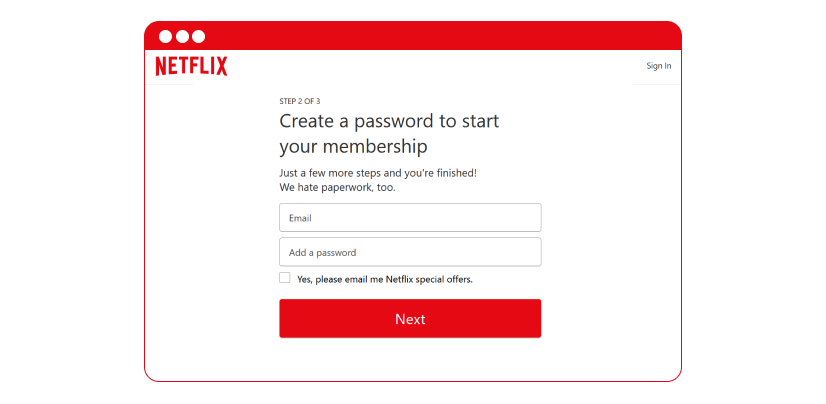
Place static embedded forms in noticeable areas on high-traffic web pages, like sidebars, splash pages, headers, and footers. Some tips to make the form effective:
- make your form clear, easy to understand and complete;
- only request the information that is necessary;
- use a one-column form since two-column sign-up forms might be distracting;
- employ a visible, clear CTA button;
- inform your leads of what happens after they fill out the form.
Embedded forms have the advantage of being not disruptive. They do nothing more than gently remind visitors that they have the choice to sign up. This not only captures engaged users but also integrates the process into their natural browsing experience.
2. Strategic placement of sign-up forms
The art of list-building extends beyond the mere existence of sign-up forms; it lies in their strategic placement. Once a signup form for email address collection has been created, it should be placed where it will be seen by the greatest number of website visitors.
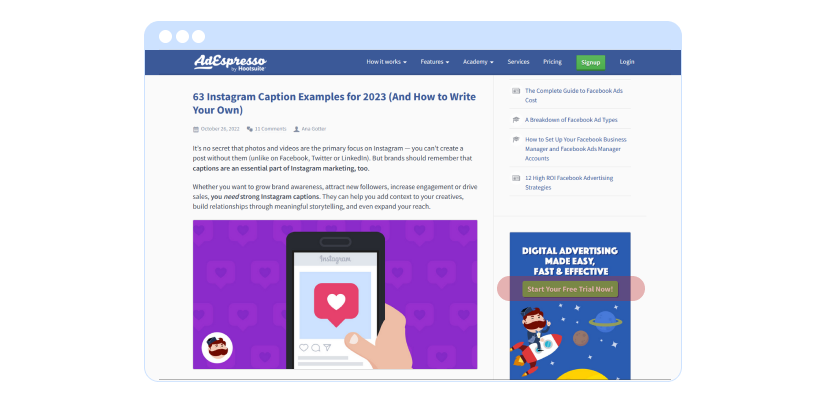
Positioning these forms at the most popular touchpoints—such as the sidebar of your website, after insightful blog posts, or within product pages—maximizes their visibility and impact. To find the most successful combinations, experiment with different CTA button colors, sizes, text, and placements. This tactical deployment ensures that your audience receives the invitation at precisely the right moment.
3. Promoting sign-ups on social media
Promote email sign-ups on your social media channels to expand your reach beyond the bounds of your website. The idea is to effortlessly transform your social audience into email subscribers, whether through engaging posts, stories, or targeted social marketing.
Including a call to action in your bio for email signups might also aid in the expansion of your email list. Every time someone reads your bio, you have the chance to attract a new subscriber.

Consider including a subscription link in your email signature. This is an excellent approach to promoting your newsletter to those who have previously contacted you.
4. Creating incentives
Offerings such as exclusive content, downloadable resources, or time-limited discounts serve as irresistible incentives, particularly if people are unfamiliar with your company. Providing something in return for a subscription can effectively encourage visitors to sign up.
Here’s what you can offer:
- ebooks/guides
- case studies
- webinars
- audio/video podcasts
- infographics
- toolkit
- demo
- one-time discount
- coupons
- free sheeping
- physical freebies
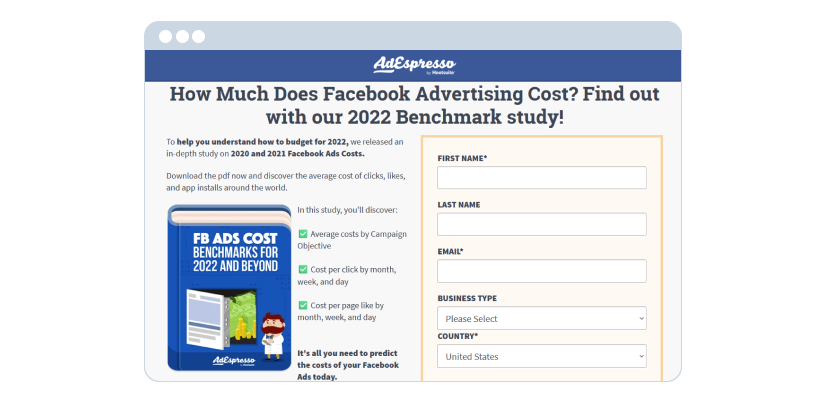
If you make the offer time-limited and conditional, you’ll push visitors to sign up right away. These offerings not only sweeten the deal for potential subscribers but also position your brand as a valuable resource.
5. Clear and personalized CTAs
A call to action is the heartbeat of any successful email list-building strategy. Crafting clear, personalized CTAs that resonate with your audience sparks the desire to subscribe. Your call to action should cater to the specific demands of the people who visit your blog post or website, as they are there to do business.
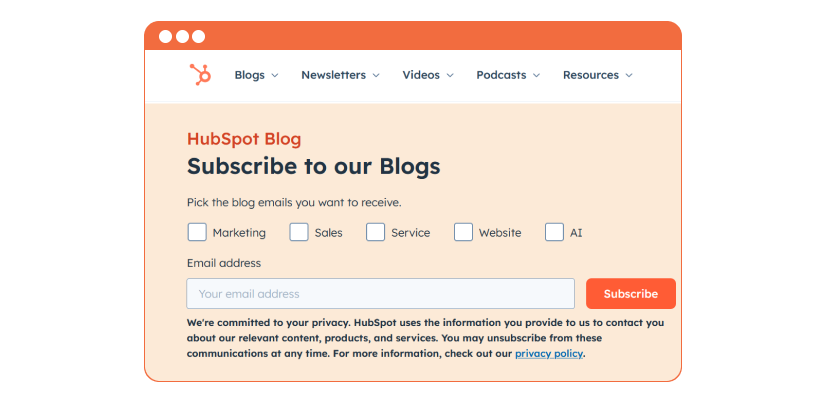
Here are the basic types of CTAs:
- buttons with an actionable phrase written on them;
- forms offering visitors something in exchange for their contact information;
- banners located along the top, bottom, or side of a webpage;
- contextual links within the body copy of a blog post;
- pop-ups that suddenly appear on the page;
- slide-ins that capture the user's attention by “sliding in” from the bottom or the sidebar.
To write a good CTA, remember to keep it simple, use action verbs, create a sense of urgency, and be creative. For example, if your blog post on "ad automation strategies" receives a lot of traffic, you could use a straightforward CTA such as "Click here to unlock exclusive automation tips" to encourage readers to sign up for your email list. Describe value in your CTA. The language should be tailored to evoke a sense of exclusivity and benefit. The key is to achieve a balance — capturing interest without disrupting the user experience.
6. Creating converting landing pages
Growing your email list may be greatly aided by dedicated landing pages. A landing page's goal is to encourage users to "land" on it. In order to get your visitor's full attention, a landing page removes distractions like navigation or links.
Tailor these pages to showcase the unique value proposition of subscribing, emphasizing the benefits and exclusivities awaiting new members. Landing pages also assist with SEO because users may directly search for "sign up for [xyz] brand's mailing list" on search engines.

Here are some of our best practices for creating a converting landing page:
- Write a benefit-focused title — visitors need to know what the page offers them as soon as they land.
- Select a picture that expresses how the offer will make the visitors feel.
- Craft engaging copy — your writing has to be precise and succinct, pointing readers toward the action you want them to take.
- Make a relevant offer — it should be attractive enough to get your visitor to share their contact information.
- Use a thank you page to not only thank users for their attention but also provide the content you promised.
This will be more convenient than directing users to your site and having them discover your sign-up form on their own. Simplicity, coupled with persuasive copy and compelling visuals, transforms a landing page from a pit-stop to a conversion powerhouse. Moreover, you can expand your audience by running targeted ads that lead users to your irresistible offers.
7. Opt-in option at checkout
The majority of internet buyers now expect that personal information will be requested at checkout. We all feel more comfortable making purchases when we get an email or text message confirming our transaction and when we know the company will keep us informed about the status of our item.
A simple checkbox or a clear prompt can invite customers to subscribe for future updates, promotions, and insider information. Because customers are ready to input their information at the checkout stage, offering the option to join an email list is a non-intrusive method to boost mailing list memberships.

This action ensures that your most engaged customers stay connected even after the transaction is complete.
8. Offer loyalty programs
You can grow your email list and encourage customers to return by implementing loyalty programs. The idea is to encourage recurring purchases and foster customer-business trust. You can offer special perks, discounts, or early access to new features to loyal subscribers.
What businesses get from reward programs:
> Customers referrals;
> Brand advocacy;
> Increased customer retention;
> Sales growth.

Here are a few examples of loyalty programs that you may modify for your company:
- Loyalty programs using a point system. The most typical kind. Consumers obtain reward points that they may exchange for benefits, discounts, freebies, and other things;
- Paid loyalty programs. For a participation fee, businesses provide clients with instant and continuing advantages. Paid programs can need a demonstration of value in order to attract participants;
- Loyalty programs with several levels of rewards. Customers are given different perks based on their rank. Membership is frequently ranked into categories based on measures like sales or involvement;
- Value-based loyalty programs. This scheme does not genuinely reward clients. It entails donating a percentage of purchases to charity. You may provide a variety of options so that your clients can select what truly fits with their ideals.
Make sure your loyalty program is simple to join and offers some truly amazing perks, such as access to members-only specials, free gifts, events, content, and more, if you want to get the most out of it and use it as a successful list-building strategy. Additionally, when they have joined up, be sure to customize their experience.
This not only encourages customers to join your email community but also fosters a sense of belonging and appreciation.
9. Contests or giveaways
Contests and giveaways may help boost list growth by making the process of subscribing a sharing and winning event. This not only humanizes your brand but also establishes a connection with your audience.
Here are the most common steps you can use while creating your content strategy:
- Define the contest theme and objectives;
- Develop a cohesive narrative for the entire contest journey;
- Curate engaging content around the contest, including visuals and copy;
- Choose prizes that align with your brand and resonate with your target audience;
- Encourage participants to share the contest with their networks;
- Provide additional benefits or entries for successful referrals;
- Express gratitude to all participants for their involvement;
- Announce winners publicly, creating a moment of celebration;
- Consider extending exclusive offers to everyone involved to sustain positive momentum.
A good way to improve this approach is by collaborating with other brands that sell to similar clientele. Your products will work better with the proper partner, strengthening the offer. Another alternative is to hunt for influencers who are already reaching out to your prospective clients on social media. Influencers often make use of giveaways to increase their following. You might partner with them and provide your product for their giveaway campaign.

Use contests as an opportunity to showcase your brand’s personality and values. The temptation of winning a prize motivates individuals to take extra steps, providing you with not just an email address but an engaged audience eager to see if they've won. This will create a sense of anticipation among your audience.
3 Marketing Tools for Managing Email Marketing
As your email list grows from a few subscribers to a few thousand, it's essential to invest in tools and platforms that will help you manage, organize, and profit from your data. To help you get started, below is a selection of essential tools tailored for email marketing management:

This email marketing tool makes it simple for businesses of all sizes to create professional, engaging marketing emails. The free plan offered by MailChimp includes basic email template creation, scheduling, and automation features. A paid subscription grants you access to more premium email templates as well as enhanced tools for analyzing your email list and campaigns.
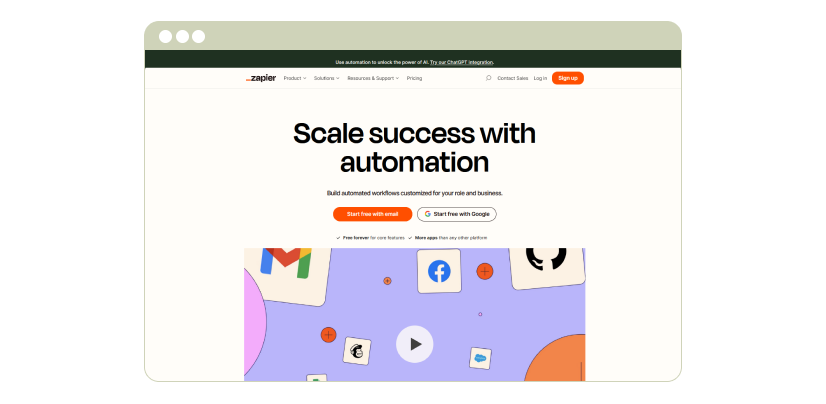
Zapier is a web-based automation solution for connecting your apps and services. You may link two or more applications to automate repetitive processes without writing code or depending on developers. From connecting your email campaigns to social media management to integrating with CRM systems, Zapier frees up valuable time for strategic tasks.
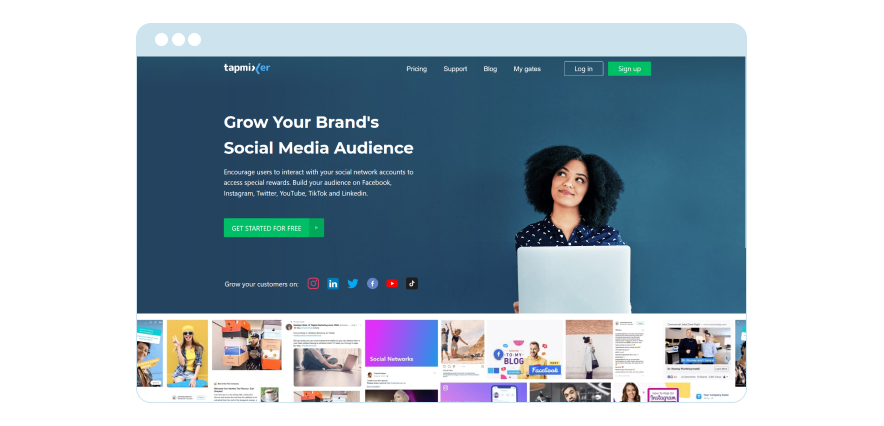
TapMixer is a standout download gate software. This tool empowers marketing managers to gate valuable content behind an email subscription, providing an incentive for users to join the email list. It's a strategic gatekeeper that not only captures emails but also ensures that the exchange is mutually beneficial, delivering exclusive content to engaged subscribers. These people, who were originally interested in the material you provide, are far more likely to become a dedicated part of your following base.
While the journey may present numerous choices, remember that the right tools are not just instruments; they are your trusted allies on the path to email marketing excellence.
Armed with these insights, launch your email marketing campaigns with confidence. Craft compelling narratives, employ user-friendly tools, and embrace innovative tactics to fortify your brand's connection with its audience. Employ these strategies and watch as your campaigns resonate, creating lasting connections.
